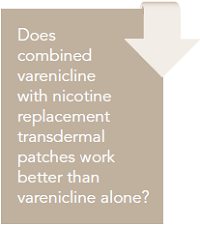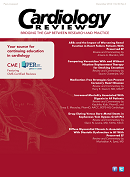Comparing Varenicline with and Without Nicotine Replacement Therapy for Smoking Cessation
While various behavioral and pharmacologic agents have proven to be effective and safe for continued smoking cessation, a combination of varenicline and nicotine replacement (NRT) with transdermal patches has not been shown definitively to be more efficacious than varenicline alone. In the framework of a randomized clinical trial (RCT), the present study evaluates whether a combination of varenicline with NRT improved smoking cessation rates and abstinence duration compared with varenicline alone.

Saurav Chatterjee, MD
Review
Koegelenberg CF, Noor F, Bateman ED, et al. Efficacy of varenicline combined with nicotine replacement therapy vs varenicline alone for smoking cessation: a randomized clinical trial. JAMA. 2014;312:155-161.

Smoking cessation remains a public health priority.While various behavioral and pharmacologic agents have proven to be effective and safe for continued smoking cessation, a combination of varenicline and nicotine replacement (NRT) with transdermal patches has not been shown definitively to be more efficacious than varenicline alone. In the framework of a randomized clinical trial (RCT), the present study evaluates whether a combination of varenicline with NRT improved smoking cessation rates and abstinence duration compared with varenicline alone.
Study Details
This study by Koegelenberg et al was a randomized, double-blinded, placebo-controlled clinical trial conducted at 7 centers in South Africa (in Cape Town, Johannesburg, and Durban), with a 12-week treatment period and a 12-week follow-up, from April 2011 to October 2012.1 A total of 446 smokers (171 men; mean age, 46.3 years) without significant comorbidities were randomized in a 1:1 ratio; 435 were included in the efficacy and safety analyses. Participants were randomized to either active 15-mg nicotine patches or placebo patch treatment for 16 hours/day, which began 2 weeks before a target quit date (TQD) and continued for an additional 12 weeks. Varenicline (0.5 mg once daily for 3 days, titrated to 0.5 mg twice daily for days 4 to 7 and then to the maintenance dose of 1 mg twice daily through week 12) was begun 1 week prior to the TQD, continued for an additional 12 weeks, and tapered off during week 13.
Tobacco abstinence was confirmed by measuring exhaled carbon monoxide using the Micro IV Smokerlyzer (Bedfont Scientific, Kent, England) at the TQD and at intervals thereafter for up to 24 weeks.
The primary end point was the 4-week exhaled carbon monoxide-confirmed continuous abstinence rate for weeks 9 through 12 of treatment. (The rate was the proportion of participants able to maintain complete abstinence from smoking for the last 4 weeks of treatment, as assessed using separate per protocol and multiple imputation analysis.) Secondary end points included point prevalence abstinence at 6 months, continuous abstinence rate from weeks 9 through 24, and adverse events.
The combination treatment was associated with a higher continuous abstinence rate at 12 weeks (55.4% vs 40.9%; OR, 1.85; 95% CI, 1.19-2.89; P = .007) and at 24 weeks (49.0% vs 32.6%; OR, 1.98; 95% CI, 1.25-3.14; P = .004), and point prevalence abstinence rate at 6 months (65.1% vs 46.7%; OR, 2.13; 95% CI, 1.32-3.43; P = .002).
The mean weight gain in those who completed 6 months of follow-up was 3.0 kg (95% CI, 2.3-3.8 kg) in the active and 2.2 kg (95% CI, 1.7-2.8 kg) in the placebo NRT groups, respectively (P = .09). In the combination treatment group, there was a numerically greater incidence of nausea, sleep disturbance, skin reactions, constipation, and depression, with only skin reactions reaching statistical significance (14.4% vs 7.8%; P = .03). The varenicline-alone group experienced more abnormal dreams and headaches.
The investigators concluded that varenicline, in combination with NRT, was more effective than varenicline alone at achieving tobacco abstinence at 12 weeks (end of treatment) and at 6 months. Further studies are needed to assess the long-term efficacy and safety of the combination.
CommentaryDifferent reports on enhancing the efficacy of varenicline with nicotine patches
Many anti-addiction modalities have been shown to be superior to placebo in achieving successful abstinence for chronic smokers.2 In a prior meta-analysis,3 varenicline was shown to be superior to both NRT (OR, 1.57; 95% CI, 1.29-1.91) and bupropion (OR, 1.59; 95% CI, 1.29-1.96), but not to an NRT combination (OR, 1.06; 95% CI, 0.75-1.48). Combination therapy with different drugs may provide a therapeutic advantage by increasing the serum nicotine concentrations and by complementary effects obtained from 2 different mechanisms of action.4,5
The physiologic basis proposed for the synergistic action appears to be that varenicline may not fully saturate the nicotinic receptors and incompletely saturated receptors may lead to only partial attenuation of nicotine cravings. If supplemental NRT is used, more receptor saturation may potentially be achieved, thereby reducing the urge to smoke.
Recently, a randomized controlled trial6 observed that the addition of nicotine patches to varenicline among smokers who smoked 10 or more cigarettes per day did not increase the efficacy of varenicline as a monotherapy. A recent randomized Spanish trial concluded that in those who smoked 20 or more cigarettes per day for 6 months prior, the combination of varenicline with the nicotine patch did not improve abstinence rates at 12 weeks and 24 weeks compared with varenicline alone when all smokers were analyzed independent of consumption level.7 In contrast, the study under current consideration showed that the efficacy of varenicline was enhanced by the addition of nicotine patches.1
Reported randomized studies that have measured the effectiveness of combining varenicline with nicotine patches have had incongruent reports.1,7 A study by Hajek et al,6 which used the same method as the present trial with medication started as per labeling, found no effect of the combination treatment at 3 months; in the current study, patch use was started 2 weeks prior to target quit date. Thus, a possibility remains that the results could reflect the effects of “nicotine preloading” rather than those of medication combination.1 The 2 studies that did not show significant benefit of combination therapy included smokers of 20 cigarettes or more,6,7 in contrast to this study1 in which the participants smoked of 10 or more cigarettes. Finally, another potential limitation is the possibility for bias with nonpharmacologic interventions, such as simultaneous behavioral interventions that some subjects may have used.
References
1. Koegelenberg CF, Noor F, Bateman ED, et al. Efficacy of varenicline combined with nicotine replacement therapy vs varenicline alone for smoking cessation: a randomized clinical trial. JAMA. 2014;312:155-161.
2. Mills EJ, Wu P, Lockhart I, Thorlund K, Puhan M, Ebbert JO. Comparisons of high-dose and combination nicotine replacement therapy, varenicline, and bupropion for smoking cessation: a systematic review and multiple treatment meta-analysis. Ann Med. 2012;44:588-597.
3. Cahill K, Stevens S, Perera R, Lancaster T. Pharmacological interventions for smoking cessation: an overview and network meta-analysis. Cochrane Database Syst Rev. 2013;5:CD009329.
4. Shah SD, Wilken LA, Winkler SR, Lin SJ. Systematic review and meta-analysis of combination therapy for smoking cessation. J Am Pharm Assoc. 2008;48:659-665.
5. Oncken C, Gonzales D, Nides M, et al. Efficacy and safety of the novel selective nicotinic acetylcholine receptor partial agonist, varenicline, for smoking cessation. Arch Intern Med. 2006;166:1571-1577.
6. Hajek P, Smith KM, Dhanji AR, McRobbie H. Is a combination of varenicline and nicotine patch more effective in helping smokers quit than varenicline alone? A randomised controlled trial. BMC Med. 2013;11:140.
7. Ramon JM, Morchon S, Baena A, Masuet-Aumatell C. Combining varenicline and nicotine patches: a randomized controlled trial study in smoking cessation. BMC Med. 2014;12(1):172.
About the Author
Saurav Chatterjee, MD, is clinical and research fellow in cardiology at the St Luke’s-Roosevelt Hospital of the Columbia University of Physicians and Surgeons. He graduated from Calcutta National Medical College with honors and was a resident in cardiology in Mercy Hospital, Kolkata, India, as well as trial coordinator of the CRESCENDO trial in Kolkata, India. He recently completed his residency in internal medicine at Maimonides Medical Center in Brooklyn, NY, and was Clinical and Research Fellow in Preventive Cardiology and Outcomes Research at Brown University and Providence VAMC in Providence, Rhode Island. Dr Chatterjee is the recipient of the 2012 Young Investigator Award for Health Outcomes and Population Genetics at the Annual Scientific Sessions of the American College of Cardiology 2012 in Chicago, and also the 2011 American Association of Cardiologists of Indian Origin (AACIO) Young Investigator Award for Interventional Cardiology and Electrophysiology.
